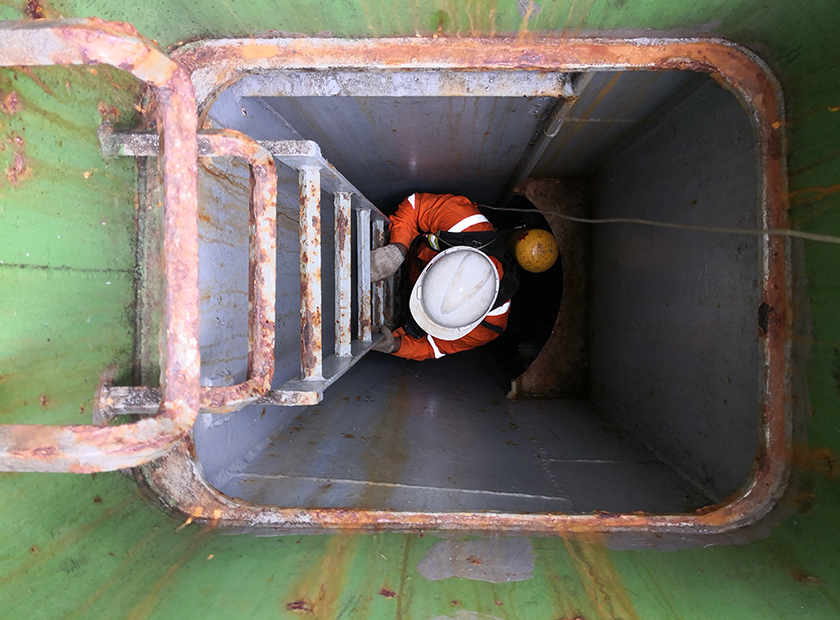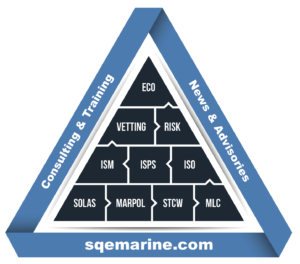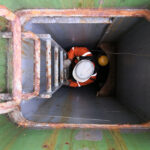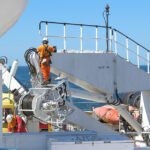Overview
The China Maritime Safety Administration (MSA) has issued a notice announcing the launch of a Special Campaign against Illegal Entry into Enclosed Spaces onboard Ships. The notice informs that maritime management agencies at all levels will conduct detailed inspections for enclosed space entry procedures implementation in conjunction with daily ship safety inspections.
These extra inspections will take place in the period 15 January 2025 – 14 October 2025.
Background
Enclosed spaces include, but are not limited to, cargo spaces, double bottoms, fuel tanks, ballast tanks, cargo pump-rooms, cargo compressor rooms, cofferdams, chain lockers, void spaces, duct keels, inter-barrier spaces, boilers, engine crankcases, engine scavenge air receivers, sewage tanks, and the adjacent connected spaces which are normally unventilated and not used for cargo storage but which may share the same atmospheric characteristics with the enclosed spaces.
During the campaign period, Chinese Port State Control Officers will conduct special enclosed space entry inspections when onboard. The correspondents report that inspectors will pay particular attention to topics such as:
- Crew training and hazard awareness, including identification of all onboard locations/spaces in which a hazardous atmosphere could develop.
- Permit to work system, including barriers and markings to prevent unauthorized entry.
- Availability of relevant and well-maintained atmosphere testing and rescue equipment, as well as crews’ familiarity with the equipment.
- Conducted enclosed space entry drills in accordance with SOLAS Reg.III/19.3.3.
Items to be checked during the Focus Inspection
Focus inspection will be conducted based on a specific 10 items checklist, as per Appendix A.
Actions required
Ship owners/managers should be prepared for inspections even if their managed ships are not eligible for a normal PSC inspection. Masters should have their ships ready for PSC Inspection and particularly for Focused inspection on enclosed space entry procedures as follows:
- Review the SMS enclosed entry procedures
- Have a ship specific list for spaces that are qualified for ENCLOSED SPACE ENTRY procedures implementation
- Conduct a drill for rescue from enclosed space to verify the crew training status on procedures.
- Assume rectification actions as may be required.
How we may help
SQEMARINE can provide guidance for Focus Questions (Appendix A), prepare the response to questions (Appendix B) and provide related Deficiency code analysis Globally (Appendix C).
Appendix A: Focus Inspection Questions
| No. | Description |
| 1. | Are crew members responsible for enclosed space entry aware of the associated risks? |
| 2. | Are the measures in place to permit to work for visitors and crew members for enclosed space entry? |
| 3. | Is there a list of enclosed space identified? |
| 4. | Are the enclosed spaces marked and for authorized personnel only? |
| 5. | Are the atmosphere testing devices regularly checked and calibrated? |
| 6. | Are the emergency rescue equipment for enclosed space entry in good condition? |
| 7. | Are the personnel familiar with the operation of safety protective equipment and devices? |
| 8. | Are the personnel familiar with the safe entry and risk assessment procedures for enclosed space? |
| 9. | Is the enclosed space entry and rescue drill in accordance with SOLAS Chapter III, Regulation 19.3.3? |
| 10. | Is the SMS related to enclosed space operations effectively implemented on board? |
Appendix B: Best Practice Guidance on Focus Inspection Questions
1. Are crew members responsible for enclosed space entry aware of the associated risks?
SMS enclosed space entry procedures clearly define roles and responsibilities for identifying and entering enclosed spaces on board.
2. Are the measures in place to permit to work for visitors and crew members for enclosed space entry?
Identified enclosed spaces must only be entered after the Enclosed Space Entry Permit has been issued and reviewed. This practice must also be implemented for visitors, regardless of rank. The Safety Officer is responsible for ensuring proper implementation of the procedures and the Enclosed Space Entry Permit.
3. Is there a list of enclosed space identified?
Each ship, in addition to the generic identification of spaces through the SMS, should maintain a specific list of spaces identified as requiring the Enclosed Space Entry Procedure. An enclosed space is defined as a space that possesses any of the following characteristics:
- Limited openings for entry and exit.
- Inadequate ventilation.
- Not designed for continuous worker occupancy.
4. Are the enclosed spaces marked and for authorized personnel only?
All spaces identified as requiring the Enclosed Space Entry Procedure must be clearly marked with posted notifications at entry points, warning that an Enclosed Space Entry Permit is required. Entry is not permitted without the permit in hand and prior notification to the Officer of the Watch.
5. Are the atmosphere testing devices regularly checked and calibrated?
Atmosphere equipment checking devises to be checked and calibrated by a competent person as per manufacturer’s instructions and SMS requirements. Records of inspection and calibration to be available for inspection.
6. Are the emergency rescue equipment for enclosed space entry in good condition?
Equipment used for enclosed space entry (breathing apparatus, personal air testing devices, internal comms, applicable clothing, stretchers, head and eyes protection etc) to be checked and inspected as per SMS procedures and manufacturer’s guidance. Records of inspections and equipment maintenance to be kept for inspection.
7. Are the personnel familiar with the operation of safety protective equipment and devices?
Personnel involved in enclosed space entry must be familiar with the use of applicable equipment. Specialized training should be provided for the use of atmosphere testing equipment and the procedures for accurately measuring air quality within a space before entry.
8. Are the personnel familiar with the safe entry and risk assessment procedures for enclosed space?
Each enclosed space entry permit should be accompanied by an effective Risk Assessment conducted prior entering in order to identify and mitigate hazards. The Safety Officer is responsible to implement all measures identified in Risk Assessment, and are listed in Enclosed Space entry permit.
9. Is the enclosed space entry and rescue drill in accordance with SOLAS Chapter III, Regulation 19.3.3?
An effective rescue drill for enclosed space entry must be conducted every 2 months, in accordance with SOLAS requirements. A drill schedule should be available as per the SMS, and records of the drills (including drill evaluations) must be kept on board.
10. Is the SMS related to enclosed space operations effectively implemented on board?
The company should verify the effective implementation of enclosed space entry procedures during internal audits and superintendent visits on board. The Master, during the SMS review, must report any discrepancies found. After each enclosed space entry drill, an evaluation report, including comments, should be submitted to the office.
Appendix C: Related PSC Deficiency code analysis Globally
Deficiency Codes Related to Inspection Campaign
(Source RiSK4SEA)
| No. | Description | Related PSC Deficiency Codes |
| 1. | Are crew members responsible for enclosed space entry aware of the associated risks? | 09221 – Entry dangerous spaces 18415 – Entry dangerous spaces |
| 2. | Are the measures in place to permit to work for visitors and crew members for enclosed space entry? | 09221 – Entry dangerous spaces 12110 – Tank entry 18415 – Entry dangerous spaces |
| 3. | Is there a list of enclosed space identified? | 09221 – Entry dangerous spaces 18415 – Entry dangerous spaces |
| 4. | Are the enclosed spaces marked and for authorized personnel only? | 01310 – Signs, indications 18413 – Warning notices |
| 5. | Are the atmosphere testing devices regularly checked and calibrated? | 06105 – Atmosphere testing instruments 18410 – Gas instruments |
| 6. | Are the emergency rescue equipment for enclosed space entry in good condition? | 09221 – Entry dangerous spaces 18415 – Entry dangerous spaces |
| 7. | Are the personnel familiar with the operation of safety protective equipment and devices? | 09221 – Entry dangerous spaces 18412 – Personal Protective equipment |
| 8. | Are the personnel familiar with the safe entry and risk assessment procedures for enclosed space? | 04118 – Enclosed space entry and rescue drills 18415 – Entry dangerous spaces |
| 9. | Is the enclosed space entry and rescue drill in accordance with SOLAS Chapter III, Regulation 19.3.3? | 04108 – Muster list 04118 – Enclosed space entry and rescue drills 15107 – Emergency preparedness |
| 10. | Is the SMS related to enclosed space operations effectively implemented on board? | 04118 – Enclosed space entry and rescue drills 15106 – Shipboard operations |
Analysis of related Deficiency Codes
Last 36 Months Global Statistics (sorted by Global Ranking)
(Source RiSK4SEA)
| Global Rank | DC | Deficiency Code Description | Deficiency Area | # DET Defs | # NON DET Defs | Total DEFs | Share |
| 53 | 04108 | Muster list | Emergency Systems | 60 | 2,209 | 2,269 | 0.50% |
| 69 | 01310 | Signs, indications | Certificate & Documentation | 8 | 1,774 | 1,782 | 0.40% |
| 123 | 04118 | Enclosed space entry and rescue drills | Emergency Systems | 65 | 958 | 1,023 | 0.23% |
| 151 | 18412 | Personal Protective equipment | MLC | 11 | 736 | 747 | 0.17% |
| 185 | 15106 | Shipboard operations | ISM Code | 115 | 459 | 574 | 0.13% |
| 198 | 06105 | Atmosphere testing instruments | Cargo Ops including Equipment | 44 | 484 | 528 | 0.12% |
| 200 | 18410 | Gas instruments | MLC | 33 | 483 | 516 | 0.11% |
| 233 | 18413 | Warning notices | MLC | – | 383 | 383 | 0.09% |
| 290 | 15107 | Emergency preparedness | ISM Code | 34 | 191 | 225 | 0.05% |
| 298 | 18415 | Entry dangerous spaces | MLC | 7 | 205 | 212 | 0.05% |
| 422 | 09221 | Entry dangerous spaces | MLC | 2 | 58 | 60 | 0.01% |
| 541 | 12110 | Tank entry | Dangerous Goods | – | 10 | 10 | <0.01% |
Global rank: The rank of deficiency code taking into consideration the findings of last 36 months.
DC: Deficiency Code
DC Description: The description of specific deficiency code
Deficiency Area: The area the deficiency code is assigned as per global PSC system
# of DET Defs: The number of times this specific DC has led to a ship’s detention
# Non DET. Defs: The number of times the deficiency code has been marked on ships but without leading to detention
TTL Defs: The sum of # for DET Defs + # Non DET Defs
Share: Percentage of TTL defs to global findings for all deficiency codes L36M
Interested to receive Port Call Risk Assessment to prepare your ship for the forthcoming port call?






